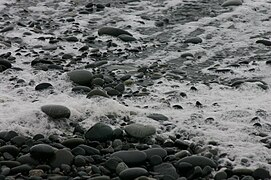Pebble
This articleneeds additional citations forverification.(December 2013) |

Apebbleis aclastofrockwith aparticle sizeof 4–64 mm (0.16–2.52 in) based on theUdden-Wentworth scaleofsedimentology.Pebbles are generally considered larger thangranules(2–4 mm (0.079–0.157 in) in diameter) and smaller thancobbles(64–256 mm (2.5–10.1 in) in diameter). A rock made predominantly of pebbles is termed aconglomerate.Pebble toolsare among the earliest known man-made artifacts, dating from thePalaeolithicperiod of human history.
A beach composed chiefly of surface pebbles is commonly termed ashingle beach.This type of beach hasarmoring characteristicswith respect to waveerosion,as well as ecological niches that providehabitatfor animals and plants.
Inshore banks of shingle (large quantities of pebbles) exist in some locations, such as the entrance to theRiver Ore,England, where the moving banks of shingle give notable navigational challenges.[1]
Pebbles come in various colors and textures and can have streaks, known asveins,ofquartzor otherminerals.Pebbles are mostly smooth but, dependent on how frequently they come in contact with the sea, they can have marks of contact with other rocks or other pebbles. Pebbles left above thehigh water markmay have growths of organisms such aslichenon them, signifying the lack of contact withseawater.
Location[edit]
Pebbles on Earth exist in two types of locations – on the beaches of various oceans and seas, and inland where ancient seas used to cover the land. Then, when the seas retreated, the rocks became landlocked.[citation needed]Here, they entered lakes and ponds, and form inrivers,travelling intoestuarieswhere the smoothing continues in the sea.
Beach pebbles and river pebbles (also known as river rock) are distinct in their geological formation and appearance.
Beach[edit]

Beach pebbles form gradually over time as the ocean water washes over loose rock particles. The result is a smooth, rounded appearance. The typical size range is from 2 mm to 50 mm. The colors range from translucent white to black, and include shades of yellow, brown, red and green. Some of the more plentiful pebble beaches are along the coast of thePacific Ocean,beginning in Canada and extending down to the tip of South America in Argentina. Other pebble beaches are in northern Europe (particularly on the beaches of theNorwegian Sea), along the coast of the U.K. and Ireland, on the shores of Australia, and around the islands of Indonesia and Japan.
Inland[edit]

Inland pebbles (river pebbles of river rock) are usually found along the shores of large rivers and lakes. These pebbles form as the flowing water washes over rock particles on the bottom and along the shores of theriver.The smoothness and color of river pebbles depends on several factors, such as the composition of thesoilof the river banks, the chemical characteristics of the water, and the speed of thecurrent.Because river current is gentler than theocean waves,river pebbles are usually not as smooth as beach pebbles. The most common colors of river rock are black, grey, green, brown and white.
Human use[edit]

Beach pebbles and river pebbles are used for a variety of purposes, both outdoors and indoors. They can be sorted by colour and size, and they can also be polished to improve the texture and colour. Outdoors, beach pebbles are often used forlandscaping,constructionand as decorative elements. Beach pebbles are often used to cover walkways and driveways, around pools, in and around plant containers, on patios and decks. Beach and river pebbles are also used to create water-smart gardens in areas where water is scarce. Small pebbles are also used to create living spaces and gardens on the rooftops of buildings. Indoors, pebbles can be used asbookendsandpaperweights.Large pebbles are also used to create "pet rocks"for children.
Mars[edit]
OnMars,slabs of pebbly conglomerate rock have been found and have been interpreted by scientists as having formed in an ancient streambed. The gravels, which were discovered byNASA's Mars roverCuriosity,range from the size of sand particles to the size of golf balls. Analysis has shown that the pebbles were deposited by a stream that flowed at walking pace and was ankle- to hip-deep.[2]
Gallery[edit]
-
Pebbles given a rounded shape by wave action
-
Pebbles on a beach at Broulee, Australia
See also[edit]
References[edit]
- ^"Ore and Alde, Rivers - East Coast: pilotage, charts, photos and marine business listings".visitmyharbour.
- ^"NASA Rover Finds Old Streambed on Martian Surface".News.Jet Propulsion Laboratory/California Institute of Technology.27 September 2012.Retrieved28 February2016.
External links[edit]
![]() Media related toPebblesat Wikimedia Commons
Media related toPebblesat Wikimedia Commons





